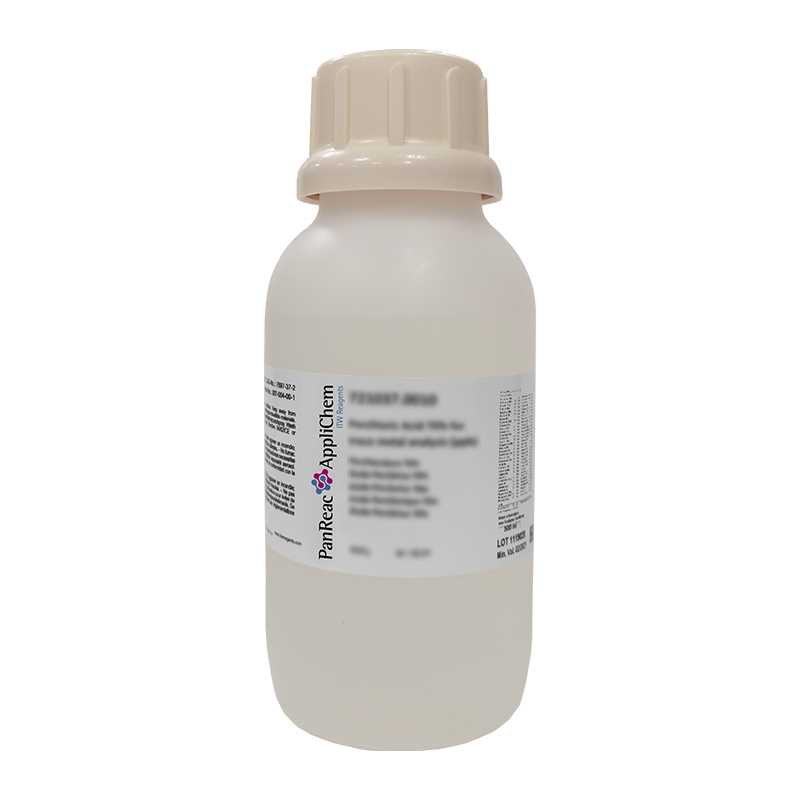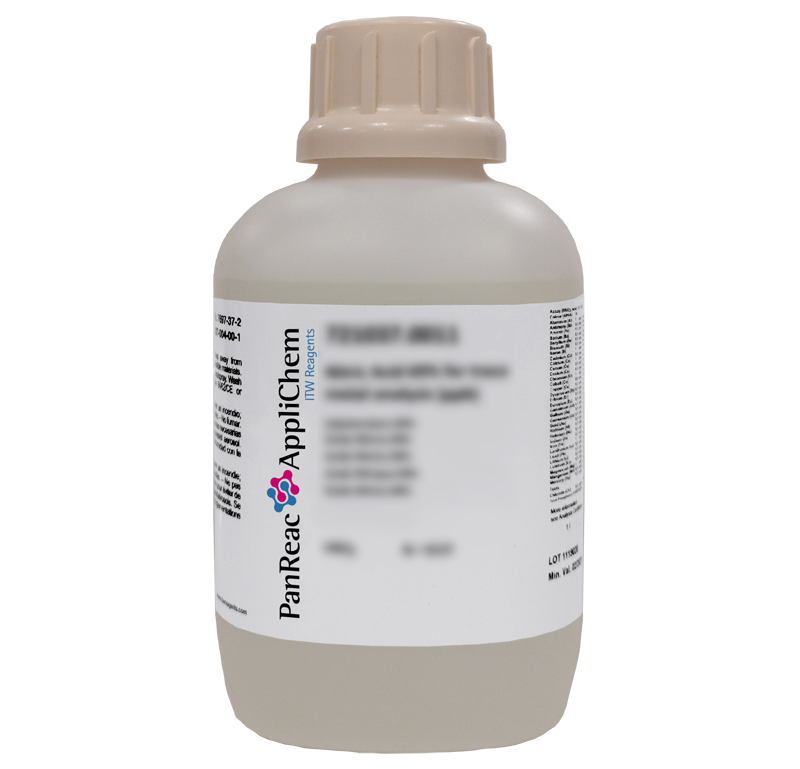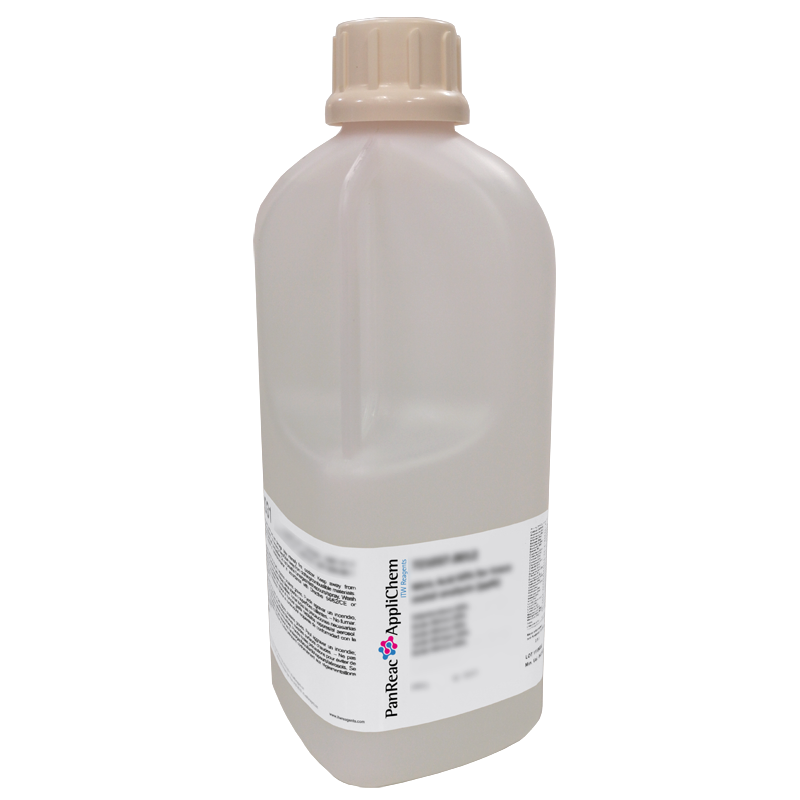Packs sizes (3)
| code | packaging size | price per unit | box price per unit | |
|---|---|---|---|---|
| Code & packaging | Price per piece | |||

|
code
721019.0010
|
packaging size
500 ml
|
price per unit
single
178,80€
|
box price per unit
|

|
code
721019.0011
|
packaging size
1000 ml
|
price per unit
single
238,60€
|
box price per unit
|

|
code
721019.0012
|
packaging size
2.5 l
|
price per unit
single
348,40€
|
box price per unit
|
Technical data
- Melting Point:
- -26 °C
- Boiling Point:
- 85 °C
- Density:
- 1.185 kg/l
- Physical Description:
- liquid
- Product Code:
- 721019
- Product Name:
- Hydrochloric Acid 35% for trace metal analysis (ppb)
- Quality Name:
- for trace metal analysis (ppb)
- Specifications:
- Assay (Acidim.): 34-37 %
Maximum limit of impurities
APHA colour: 10
Chlorine Free (Cl): 0.00005%
Bromide (Br): 0.001%
Total Sulfur: 0.00003%
Total Phosphorus: 0.000001%
Metals by ICP (ppb)
Ag: 1
Al: 1
As: 0.5
Au: 0.5
B: 1
Ba: 0.1
Be: 0.1
Bi: 0.1
Ca: 1
Cd: 0.1
Ce: 0.1
Co: 0.1
Cr: 0.5
Cs: 0.1
Cu: 0.5
Dy: 0.1
Er: 0.1
Eu: 0.1
Fe: 1
Ga: 0.1
Gd: 0.1
Hf: 0.1
Hg: 0.1
Ho: 0.1
In: 0.1
K: 1
La: 0.1
Li: 0.1
Lu: 0.1
Mg: 0.5
Mn: 0.1
Mo: 0.1
Na: 1
Nb: 0.1
Nd: 0.1
Ni: 0.5
Pb: 0.1
Pr: 0.1
Rb: 0.1
Re: 0.1
Rh: 0.1
Ru: 0.1
Sb: 0.5
Sc: 0.1
Se: 1
Sm: 0.1
Sn: 0.5
Sr: 0.1
Tb: 0.1
Te: 0.1
Th: 0.1
Ti: 0.5
Tl: 0.1
Tm: 0.1
U: 0.1
V: 0.5
W: 0.1
Y: 0.1
Yb: 0.1
Zn: 1
Zr: 0.1
- Hazard pictograms
-
- UN:
- 1789
- Class/PG:
- 8/II
- ADR:
- 8/II
- IMDG:
- 8/II
- IATA:
- 8/II
- WGK:
- 1
- Storage:
- Room Temperature.
- Signal Word:
- Danger
- GHS Symbols:
- GHS05
GHS07
- H Phrases:
- H314
H335
H290
- P Phrases:
- P260
P261
P264
P271
P280
P301+P330+P331
P303+P361+P353
P304+P340
P305+P351+P338
P310
P312
P321
P338
P363
P403+P233
P405
P501
- Master Name:
- Hydrochloric Acid 35%
- Synonyms Long Text:
- Muriatic Acid
- EINECS:
- 231-595-7
- CS:
- 28061000
- Index Nr.:
- 017-002-01-X
Documents
Inquiry
Comments
Hydrochloric acid - HClHydrochloric acid is an aqueous solution of hydrogen chloride gas protonated into oxonium and chloride ions. It is a strong inorganic acid and belongs to the mineral acids. Its salts are called chlorides, the best known being sodium chloride (NaCl, table salt).
History
Indirectly, its use is already mentioned by Pliny, in the separation of gold and silver in mining, since at high temperatures common salt and vitriol form hydrochloric acid, which forms a compound with silver. Possibly Georgius Agricola mentions a similar process for the separation of silver in his De Re Metallica of 1556 (the recipe given would give hydrochloric acid if by salt is meant common salt). Pseudo-Geber (13th century) described a reaction of mercury after heating it with common salt and alum or ferrous sulfate, forming fine white needles of mercuric chloride by reaction with hydrochloric acid. He and the medieval alchemists also knew about aqua regia, which was produced by adding saline ammonia (ammonium chloride) or common salt to nitric acid. In the 15th century, hydrochloric acid and its use for softening bones and ivory for carving is mentioned, first in an anonymous Italian manuscript from the mid-15th century, located at the University of Bologna, and then in a recipe by Caterina Sforza (1490). Both authors elaborated it by heating common salt and vitriol and distilling. - In the first half of the 15th century, Basilius Valentinus obtained hydrochloric acid by reacting halite (rock salt) with iron vitriol. In 1597 Libavius mentions hydrochloric acid in his book Alchemia, but it was also mentioned by Giambattista della Porta (Magiae Naturalis 1558, 1589) as the best means of whitening teeth. Its large-scale production from table salt and sulfuric acid was achieved by Johann Rudolph Glauber in the 17th century. Lavoisier called hydrochloric acid acide muriatique (Latin muria 'brine'). Saline springs are still called muriatic springs today. In North America, hydrochloric acid is also called muriatic acid.
Presence
In nature, hydrochloric acid is found in volcanic gases and very dilute in crater lakes. In free form, it is found in the gastric juices of vertebrates (0.1 to 0.5 percent by mass). Deposits of hydrochloric acid salts, as rock salt and dissolved in seawater, are almost inexhaustible. -
Preparation and extraction
Hydrochloric acid is produced in the laboratory from concentrated sulfuric acid and common salt (hence the name):
NaCl + H2SO4 → NaHSO4 + HCl.
Sulfuric acid displaces hydrogen chloride from its salt. Since hydrogen chloride is gaseous, it is constantly removed from the equilibrium, which is thus almost completely on the product side. The sodium hydrogen sulfate formed is an acid salt of sulfuric acid. The resulting gaseous hydrogen chloride is introduced into water:
HCl + H2O → H3O+ + Cl-
Hydrochloric acid with higher hydrogen chloride mass fractions is also called fuming hydrochloric acid, because hydrogen chloride gas escapes and hydrochloric acid is formed again with water from atmospheric moisture, so that a white mist forms above open containers. In the chemical industry, high-purity hydrogen chloride is obtained by reacting hydrogen with chlorine:
H2 + Cl2 → 2 HCl
Here hydrogen chloride is also allowed to react with water. Technically pure hydrochloric acid is mainly produced as a by-product in the chlorination of organic compounds. - Gaseous hydrogen chloride dissolves very well in water: at 0 °C, one liter of water, provided it is present as a liquid phase, dissolves 815 g or 507 liters of gas with heat generation. At 20 °C, one liter of saturated hydrochloric acid contains 720 g of HCl. The concentration dependence of the density appears to be a simple mathematical relationship between the density of the solution and the percentage content of hydrogen chloride: The doubled decimals correspond approximately to the concentration, e.g., a hydrochloric acid of density 1.10 g-cm-3 at an HCl content of 20 percent.
% = 200 * (Density - 1)
The melting and boiling behavior of hydrochloric acid depends largely on its composition. In the solid phase, four stoichiometric hydrates with defined melting points are formed. These are a monohydrated HCl * H2O with a melting point at -15 °C, a dihydrated HCl * 2 H2O with a melting point at -18 °C, a trihydrated HCl * 3 H2O with a melting point at -25 °C, and a hexahydrated HCl * 6 H2O with a melting point at -70 °C. In the phase diagram the corresponding eutectic melts are obtained for compositions between the stoichiometric hydrates.
These are at -23 °C for a mixture of mono- and dihydrate with a hydrogen chloride mass fraction of 57.3%, of di- and trihydrate with a mass fraction of 44.0% at -28 °C, of tri- and hexahydrate with a mass fraction of 26.6% at -73 °C, and of hexahydrate and ice with a mass fraction of 23.0% at -75 °C. In addition, a metastable eutectic is formed between the trihydrate and ice with a mass fraction of 24.8% at -87 °C. Thus, in the concentration range from 0 to 25 %, a sharp decrease of the melting point is observed. The vapor-liquid phase diagram between hydrogen chloride and water shows a negative azeotrope. The resulting azeotropic boiling point is 109 °C at normal pressure with a mass fraction of 20.2 %. During evaporation of hydrochloric acid solutions with a concentration deviating from the azeotropic composition, the excess component preferentially evaporates first, i.e., for hydrochloric acid with a mass fraction <20.2 %, the concentration increases, and for hydrochloric acid with >20.2 %, the concentration decreases until the constant boiling azeotropic composition is reached. The boiling curve in the phase diagram above the azeotrope composition correlates with the solubility curve of hydrogen chloride in water. At 25 °C, the mass fraction is 42%, which corresponds to "fuming" hydrochloric acid.
In water, hydrogen chloride dissociates completely; 32% hydrochloric acid has a pH of -1. In humid air, gaseous hydrogen chloride forms a mist of fine hydrochloric acid droplets. Dilute hydrochloric acid is a good electrical conductor.
Reactions
When hydrochloric acid reacts with an aqueous solution of ammonia, a white smoke of ammonium chloride is formed.
HCl + NH3 → NH4Cl
Hydrochloric acid dissolves most metals, with the exception of precious metals and some others (e.g., tantalum and germanium), forming chlorides and hydrogen, unless protected by passivation.
Mg + 2 HCl → MgCl2 + H2
Well suited for removing oxide layers from metals, as metal oxides react with hydrochloric acid to form chlorides and water:
CuO + 2 H2O → CuCl2 + H2O.
Ammonium chloride can be obtained by neutralizing hydrochloric acid with an aqueous solution of ammonia:
NH3 + HCl → NH4Cl
A mixture of hydrochloric acid and nitric acid is called aqua regia because it is also capable of dissolving gold, the "king of metals." In addition to the oxidizing effect of nitrosyl chloride and nascent chlorine, the reduction of the effective concentration of gold ions by the formation of complexes also contributes to this:
Au3+ + 4 Cl- → AuCl4-
Use
Hydrochloric acid is an important basic chemical with great importance in the chemical industry as an inorganic acid. It is used, for example, in the beneficiation of ores and rock phosphate. It is used to stimulate oil and gas wells, especially in carbonate reservoirs, but also in sandstone reservoirs. It is also used, for example, to remove calcium carbonate deposits from equipment and for cleaning up after drilling with a filter gravel pack and in the boreholes themselves. In metallurgy, it is used in pickling, etching and brazing. In addition, dilute hydrochloric acid is used in construction to remove mortar residue from masonry, called acidizing. Tilers use dilute hydrochloric acid to remove the lime film from tiles after grouting.




